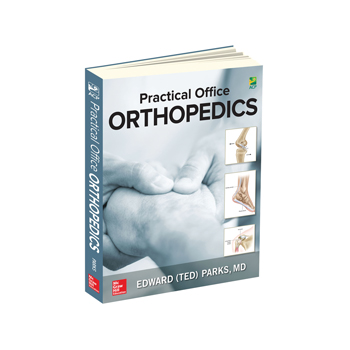New resource offers guide to ‘Practical Office Orthopedics'
Internists can practice some orthopedics in their offices, such as managing common orthopedic conditions affecting the knees, shoulders, hips, feet, ankles, hands, wrists, elbows, and spine.
Twenty years ago, a resident at the University of Colorado's medicine department was customizing his curriculum to help him realize his dream of starting a clinic for indigent patients. When he asked about doing a rotation in orthopedics, the university sent him to Edward H. “Ted” Parks, MD, an orthopedic surgeon at Western Orthopaedics in Denver and clinical professor at the University of Colorado School of Medicine in Aurora. After completing the rotation, Dr. Parks recalled, the resident told the university, “This might be a good rotation for anybody who's going into primary care.”

Ever since, Dr. Parks has taught orthopedics to a new medical resident each month. He has also spoken annually on the topic at ACP's national Internal Medicine Meetings for the past seven years. This year, his book “Practical Office Orthopedics” was published by McGraw-Hill Education in collaboration with ACP, offering primary care physicians a guide to managing common orthopedic conditions affecting the knees, shoulders, hips, feet, ankles, hands, wrists, elbows, and spine. Each chapter covers the appropriate physical examination techniques, imaging and other diagnostic studies, and medical, surgical, and follow-up treatment. The book also covers injection techniques.
ACP Internist recently spoke to Dr. Parks about his teaching style and why he feels his book is necessary reading for internists.
Q: How much of internal medicine training deals with orthopedics?
A: None. There's nothing. You can go through medical school without having an orthopedic rotation, and then if you're a primary care resident, you're likely not ever going to have a rotation in orthopedics. The residents would tell me that at the end of their residency, they felt more comfortable managing an ICU patient on six drips and a vent than taking care of an ankle sprain, and they'd be seeing a lot more ankle sprains when they started their practice.
At least half the people who become primary care providers have zero orthopedic rotation experience, and 70% of the patients who go into a primary care doctor's office have a musculoskeletal complaint, so that's crazy. I think that in the years or decades to come, this kind of thing will be a standard part of the curriculum for anybody going into primary care, but at a convenient time for me, there isn't anything like this anywhere. I think that's why it's been popular: There's a need, and there's a gap.
Q: This is your first and only book. Was it difficult to write?
A: No, really only because I've had so much time to practice it and figure out how to teach it. I just basically had to put into writing what I've been telling residents for months after months for 20 years.
The main thing was to keep it basic. I think a lot of the texts that exist in orthopedics are written by orthopedists, really kind of for orthopedists, even though they're titled as works for primary care people. We don't need to give that much detail; orthopedics isn't that complicated.
There are a couple basic principles, and we go over those in the book, and then I spend a lot of time trying to do just goofy fun stuff that makes it fun to read. This is really streamlined, easy-to-use, practical stuff. I wanted it to be kind of more like a field manual that you could take with you and it wouldn't be a big cumbersome thing that sits on a shelf somewhere, but your partner to be with you all the time and whip out when you need it.
Q: How would you describe your teaching style?
A: In medicine, what most of us are forced to do in our training is memorize these long lists of punchlines, just the punchline. And it's very hard to remember the punchline unless you have learned the joke that comes before it that makes the punchline easy to remember because it's in context. So the book, and the way I teach, spends a lot of time with the backstories behind the punchline. And instead of memorizing a long list of one-sentence facts, I have people read the stories, and they don't have to memorize anything. They'll remember it naturally. The context is so important. People who study memory seem to find that our memories aren't just record buttons on a tape recorder; a lot of imagination is involved in memory, and remembering a story is so much easier than remembering a fact.
Q: What are some of the most useful chapters for primary care physicians?
A: The thing I think that is most helpful to teach is injection techniques. Cortisone injections are really powerful tools that can be used in treating musculoskeletal patients. They're super simple to give, and the residents have no idea how to do them and they're intimidated by doing them, so they don't do them. There's a chapter at the end of this book that teaches easy injection techniques for all the different parts you'll see in orthopedics. If I had to pick what's the most valuable, I would pick that. And I think knee and shoulder are really, really important. So much of what people see in their office is going to be knee and shoulder, so those are probably the pages that will get worn out the fastest.
Q: Who will benefit most from reading this book?
A: I think anybody that has an outpatient medical practice because they're the ones that are going to see this, and that could be physicians or nurse practitioners or physician assistants. Anybody who's on the front lines administering primary care is going to need this book or something like it.




